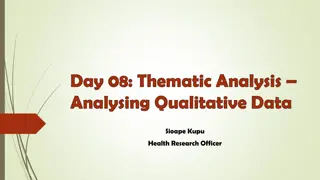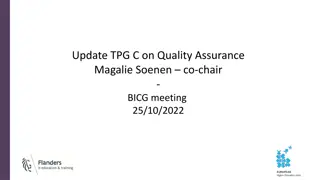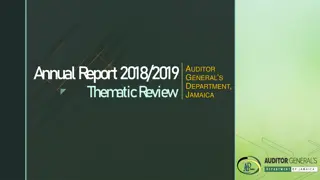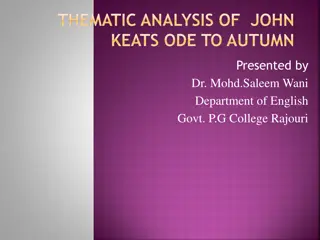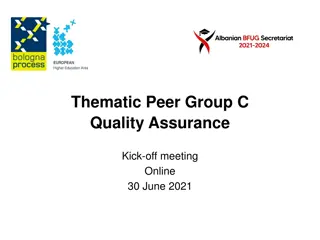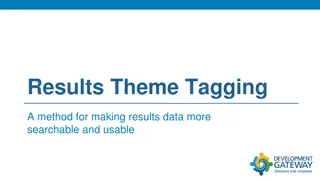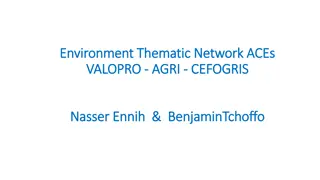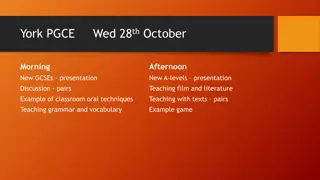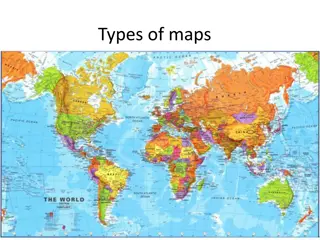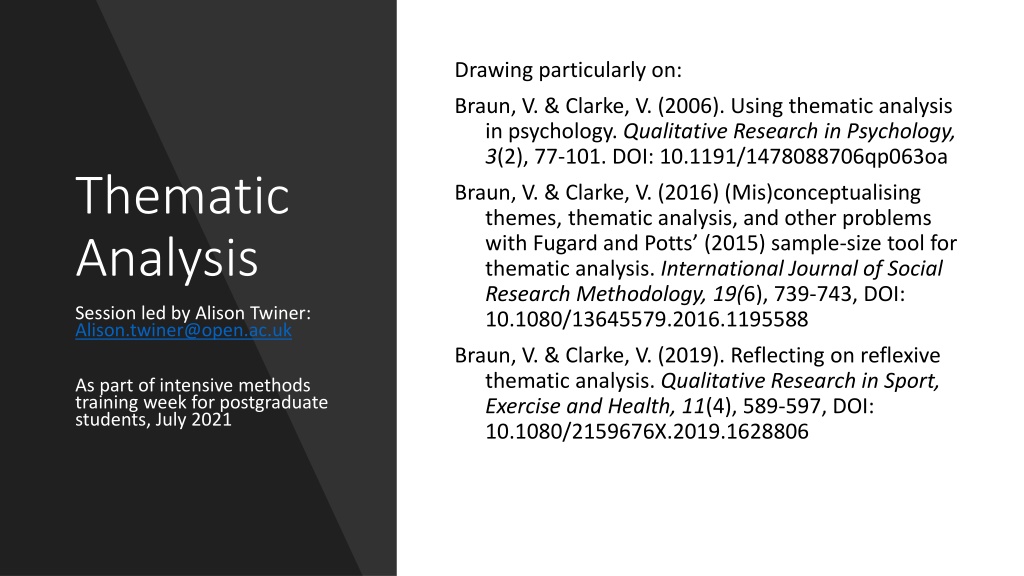
Understanding Thematic Analysis in Qualitative Research
Thematic analysis is a method used in qualitative research to identify patterns within data, providing a detailed account of findings. This approach emphasizes flexibility while requiring rigor and transparency in the analytical process.
Download Presentation

Please find below an Image/Link to download the presentation.
The content on the website is provided AS IS for your information and personal use only. It may not be sold, licensed, or shared on other websites without obtaining consent from the author. Download presentation by click this link. If you encounter any issues during the download, it is possible that the publisher has removed the file from their server.
E N D
Presentation Transcript
Drawing particularly on: Braun, V. & Clarke, V. (2006). Using thematic analysis in psychology. Qualitative Research in Psychology, 3(2), 77-101. DOI: 10.1191/1478088706qp063oa Thematic Analysis Braun, V. & Clarke, V. (2016) (Mis)conceptualising themes, thematic analysis, and other problems with Fugard and Potts (2015) sample-size tool for thematic analysis. International Journal of Social Research Methodology, 19(6), 739-743, DOI: 10.1080/13645579.2016.1195588 Session led by Alison Twiner: Alison.twiner@open.ac.uk Braun, V. & Clarke, V. (2019). Reflecting on reflexive thematic analysis. Qualitative Research in Sport, Exercise and Health, 11(4), 589-597, DOI: 10.1080/2159676X.2019.1628806 As part of intensive methods training week for postgraduate students, July 2021
In the chat, can you please comment: Are you already familiar with thematic analysis? Have you used thematic analysis before? Do you know what kinds of data you will collect? Have you already collected data?
For us, qualitative research is about meaning and meaning- making, and viewing these as always context-bound, positioned and situated, and qualitative data analysis is about telling stories , about interpreting, and creating, not discovering and finding the truth that is either out there and findable from, or buried deep within, the data. For us, the final analysis is the product of deep and prolonged data immersion, thoughtfulness and reflection, something that is active and generative. (Braun & Clarke, 2019, p. 591)
Thematic analysis is a method for identifying, analysing and reporting patterns (themes) within data. It minimally organizes and describes your data set in (rich) detail. (Braun & Clarke, 2006, p. 79) Qualitative method Can be used as a step in a process, before or alongside exploring data with other methods Theoretically flexible BUT you need to acknowledge where you ground your use of the method theoretically: Any theoretical framework carries with it a number of assumptions about the nature of the data, what they represent in terms of the the world , reality , and so forth. A good thematic analysis will make this transparent (Braun & Clarke, 2006, p. 81) What is it?
How does it differ from other approaches? In its theoretical flexibility: Through its theoretical freedom, thematic analysis provides a flexible and useful research tool, which can potentially provide a rich and detailed, yet complex, account of data. (Braun & Clarke, 2006, p. 78) Can be used to explore data in different modes e.g. video, image, written text, transcribed speech but predominantly focuses on written data Flexibility has advantages, but research also needs to evidence rigour: Importance of planning, documenting, and transparency of process You need to make some decisions, and be clear on your reasoning
inductive, or data-driven creating codes based on what a researcher identifies as meaningful, or patterns, from reading and reviewing the data. Coding in thematic analysis can be Research questions may evolve through the coding process deductive, theoretical or analyst-driven codes are often created before reviewing the data, addressing research questions or theoretical concepts from existing literature (e.g. wanting to explore how participants talk about x)
A very simplified research process overview Deductive thematic analysis Define area of research interest Set research question/s Define codes aligned to RQ Collect data Prep data for analysis Apply pre- defined codes to data Gain ethical approval Recruit participants Collect data Prep data for analysis Get familiar with data Generate codes based on what s in data Code data, set and refine research question/s Schedule data collection Inductive thematic analysis
Some terms Data corpus Data set Data item Data extract All your data Selected data for analysis Each bounded piece of data Coded piece of data e.g. all interviews, recordings, observations, photos, documents gathered during the work e.g. all interviews; e.g. one interview, one observation field note, one photo, one survey response Selection of data you have coded All data from one participant; All data about x topic
What is a theme? A theme: captures something important about the data in relation to the research question, and represents some level of patterned response or meaning within the data set (Braun & Clarke, 2006, p. 82) a central organising concept (Braun & Clarke, 2013) patterns of shared meaning underpinned by a central organising concept (Braun & Clarke, 2019, p. 589) How do we know what s important or when we identify a pattern ? How has/will prevalence or patterns in your data be influenced by the questions you ask/ed, or the activities you structure? You need to think about this before collecting data, and certainly during analysis Also differences in the field: There is no widely agreed on definition of a theme, with conceptualisations of a theme varying widely; procedures to identify themes also vary (Braun & Clarke, 2016, p. 740)
Breadth or depth? Are you exploring issues that were common across your data? Are you exploring one-offs, single themes in depth, what might be thought of as outliers in quantitative terms? Your claims based on your analysis need to match this choice e.g. e.g. what all participants think about x, someone had a completely different experience or reflection to other participants, that you may not have anticipated presenting data to illustrate all themes you identified, as a birds- eye view of all data or offering a rich description and exemplification of one theme
Where do I start? You probably already have You certainly need to whilst collecting your data Make notes of things you think about in terms of what s in the data these could become part of your data corpus
The process in a bit more detail Phase Description of the process 1. Familiarising yourself with your data Transcribing data (if necessary), reading and re-reading the data, noting down initial ideas 2. Generating initial codes Coding interesting features of the data in a systematic fashion across the entire data set, collating data relevant to each code 3. Searching for themes [has been relabelled as Generating initial themes , Braun & Clarke, 2019] Collating codes into potential themes, gathering all data relevant to each potential theme 4. Reviewing themes Checking if the themes work in relation to the coded extracts (Level 1) and the entire data set (Level 2), generating a thematic map of the analysis 5. Defining and naming themes Ongoing analysis to refine the specifics of each theme, and the overall story the analysis tells, generating clear definitions and names for each theme 6. Producing the report The final opportunity for analysis. Selection of vivid, compelling extract examples, final analysis of selected extracts, relating back from the analysis to the research question and literature, producing a scholarly report of the analysis (from Braun & Clarke, 2006)
4 1. Teaching and learning practice and interactions, and how links between education and the world of work are supported; Elements related to the world of work that should be reflected in a Virtual Internship; Media that may be valuable in Virtual Internships; Considerations for designing, maintaining and evaluating such a virtually-hosted programme; Broader policy and social context that may impact on a Virtual Internship programme and platform; Issues of how someone interacts within a Virtual Internship, or in linking between education and the world of work 1 2 3 6 2. 3. 4. 5. 5 6.
Reviewing your themes Have you got any overarching themes? Could any codes be merged? Do any codes belong to different themes? If so, do these codes need dividing to be more meaningful within each code? Do you need a miscellaneous theme for codes that don t really fit anywhere? Do they deserve attention? When you ve got candidate themes review all data under each theme to identify if it tells a coherent story. Does your thematic map reflect the meanings in your data (or what you are drawing attention to through a deductive analysis)? Is it helpful to think of themes and subthemes? Do any extracts need reallocating?
How do I know I ve finished? In terms of coding: when reviewing themes and coded extracts does not identify anything new In terms of your research overall: Writing is an integral part of analysis, not something that takes place at the end (Braun & Clarke, 2006, p. 86)
When youve got a thematic map youre happy with what are your themes about? what do they uniquely represent in your data? each theme should be sufficiently descriptive and distinct, but not try to cover too much ground Naming and defining your themes
Need transparent reporting of your analytic process the previous steps to identify rigour of your approach Telling the interesting stories and perspectives you identified through analysis for each theme - in response to your research questions (which may have evolved through analysis): with claims grounded in evidence from your data (themed data extracts); to convince readers of the integrity, relevance and authenticity of your analysis This needs to go beyond describing your data, and demonstrate critical engagement with meanings What is the contribution of your analysis to your field, and how is your write up (and selection of data evidence) making this clear? What further questions need to be researched, based on your findings? Writing up
Useful tools to support analysis You are the key tool: by immersing yourself in the data you create and define codes and themes they do not emerge from the data You don t have to code everything!
Mental health specialist: it worked really well when you were both [teachers] doing the activities as well Dance specialist: they like seeing you do it don t they Teacher: particularly with her [specific girl], because she s had to grow up in a very grown-up environment, she sees anything like that as babyish because she sees herself as a 14-year-old. She is a 14-year-old in a 5-year-old's body Where does a data extract start and end? Dance specialist: That s hard Teacher: so with us joining in, she thinks oh adults joining in as well Dance specialist: so it s OK Teacher: so it s OK, and that helps (post-lesson 2 reflection discussion)
Tech tools might help you organise your analysis, but are not essential
For us, qualitative research is about meaning and meaning- making, and viewing these as always context-bound, positioned and situated, and qualitative data analysis is about telling stories , about interpreting, and creating, not discovering and finding the truth that is either out there and findable from, or buried deep within, the data. For us, the final analysis is the product of deep and prolonged data immersion, thoughtfulness and reflection, something that is active and generative. (Braun & Clarke, 2019, p. 591)


